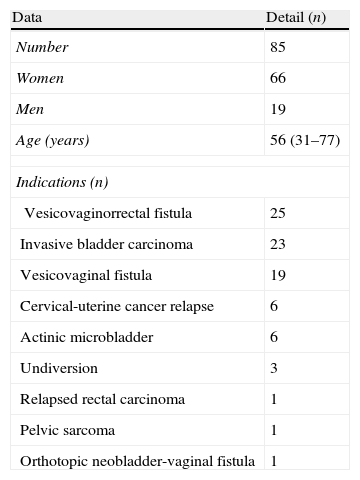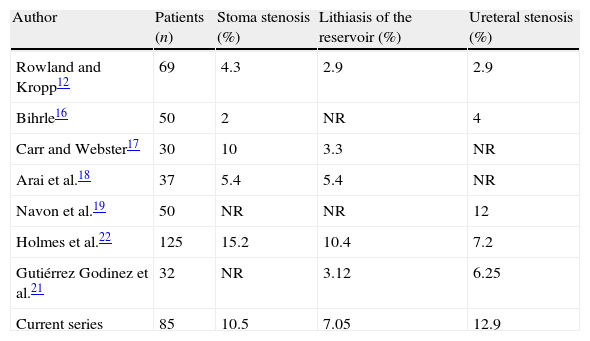Radical pelvic surgery requires continent or incontinent urinary diversion. There are many techniques, but the orthotopic neobladder is the most used. A continent catheterizable urinary reservoir is sometimes a good alternative when this derivation is not possible or not indicated. This paper has aimed to present our experience with the Indiana pouch continent urinary reservoir.
Materials and methodsThe series is made up of 85 patients, 66 women and 19 men, with a mean age of 56 years (31–77 years). Variables analyzed were operating time, estimated blood loss, transfusion rate, hospital stay and peri-operatory complications.
ResultsThe main indication in 49 cases was resolution of complications related to the treatment of cervical cancer. Average operation time was 110.5minutes (range 80–130minutes). Mean blood loss was 450cm3 (100–1000cm3). Immediate postoperative complications, all of which were treated medically, occurred in 16 patients (18.85%). One patient suffered anastomotic leakage. Hospital stay was 19 days (range 5–60 days) and there was no mortality in the series. Late complications occurred in 26 patients (32%), these being ureteral anastomotic stenosis in 11 cases, cutaneous stoma stenosis in 9 cases and reservoir stones in 6 cases.
ConclusionThe Indiana continent catheterizable urinary reservoir is a valid option for the treatment of both urological and gynecological malignancies as well as for the management of pelvic morbidity related to the treatment of pelvic cancers.
La cirugía radical pélvica requiere de una derivación urinaria, incontinente o continente. Existen numerosas técnicas, siendo la más utilizada la neovejiga ortotópica. En ocasiones, cuando esta derivación no es posible o no está indicada, un reservorio urinario continente es una buena alternativa. El objetivo de este trabajo es presentar nuestra experiencia con el reservorio urinario continente de Indiana.
Material y métodosLa serie está constituida por 85 pacientes, 66 mujeres y 19 hombres, con una edad media de 56 años (31 a 77 años). Las variables analizadas fueron el tiempo operatorio, la pérdida sanguínea, la tasa de transfusión, la estancia hospitalaria y las complicaciones perioperatorias.
ResultadosLa indicación principal fue la resolución de complicaciones derivadas del tratamiento del cáncer cérvico-uterino en 49 casos. La duración media de la derivación urinaria fue de 110,5min (rango 80-130min). El sangrado promedio fue de 450cc (rango 100-1.000cc). Hubo complicaciones postoperatorias inmediatas en 16 pacientes (18,85%), todos tratados médicamente. Un paciente tuvo una fístula anastomótica. La estancia hospitalaria fue 19 días (rango 5-60 días). No hubo mortalidad en la serie. Complicaciones alejadas ocurrieron en 26 pacientes (32%): estenosis de la anastomosis ureteral en 11 casos, estenosis del estoma cutáneo en 9 casos y litiasis del reservorio en 6 casos.
ConclusiónEl reservorio urinario continente y cateterizable de Indiana es una opción válida para el tratamiento de neoplasias urológicas o ginecológicas, y también para el manejo de enfermedades pélvicas relacionadas con complicaciones del tratamiento de cánceres pélvicos.












